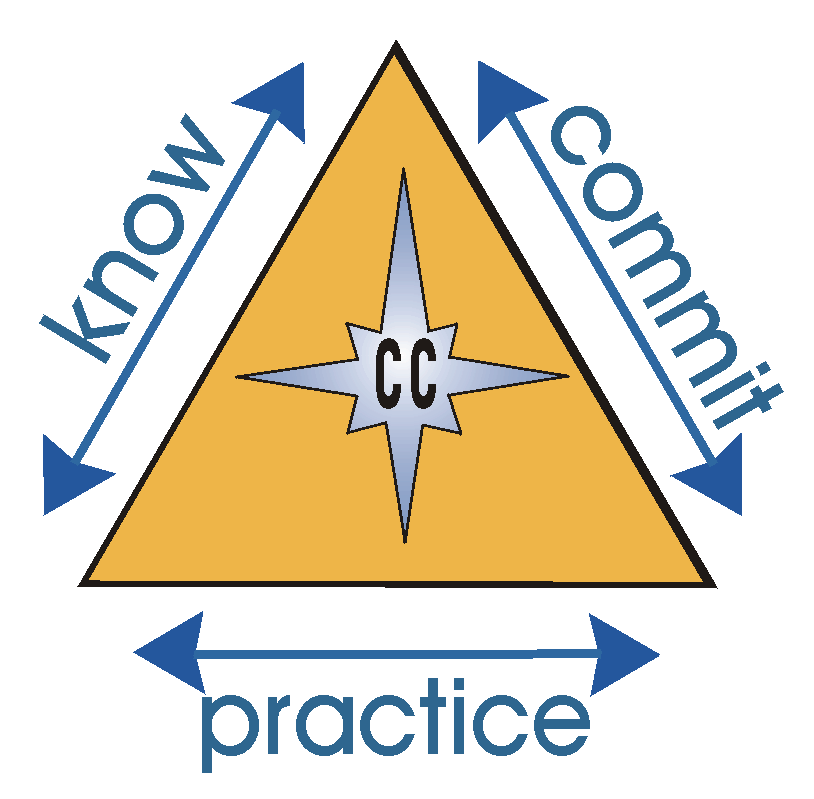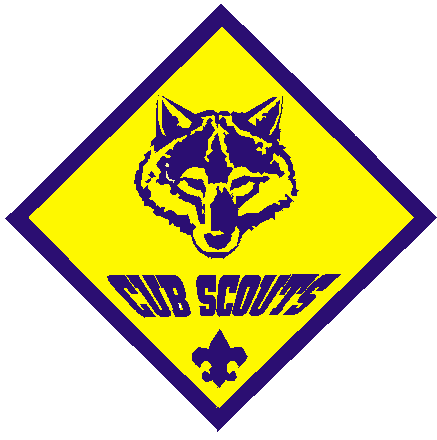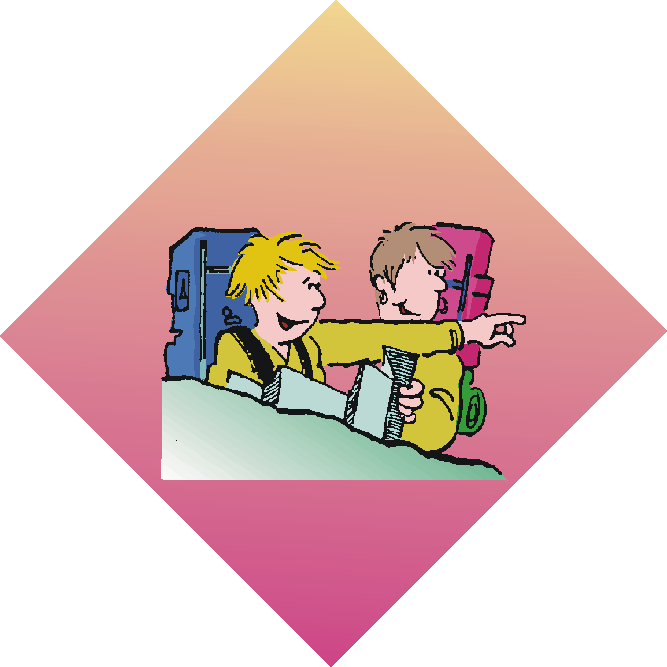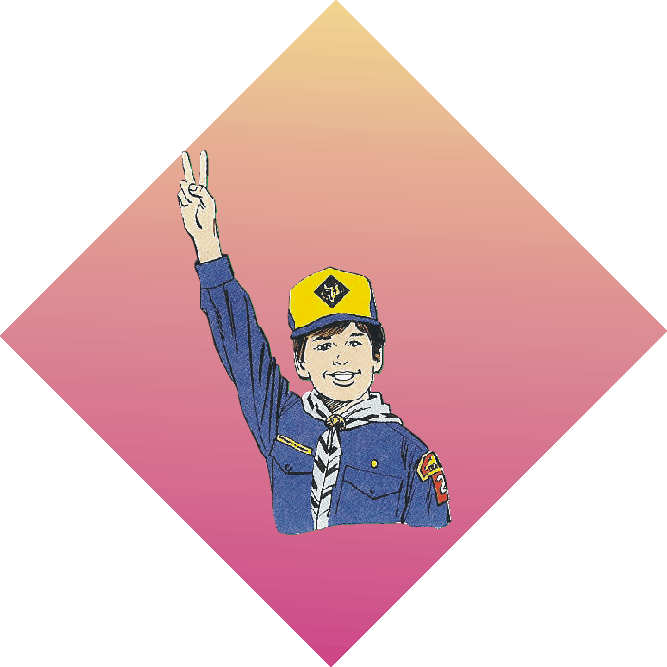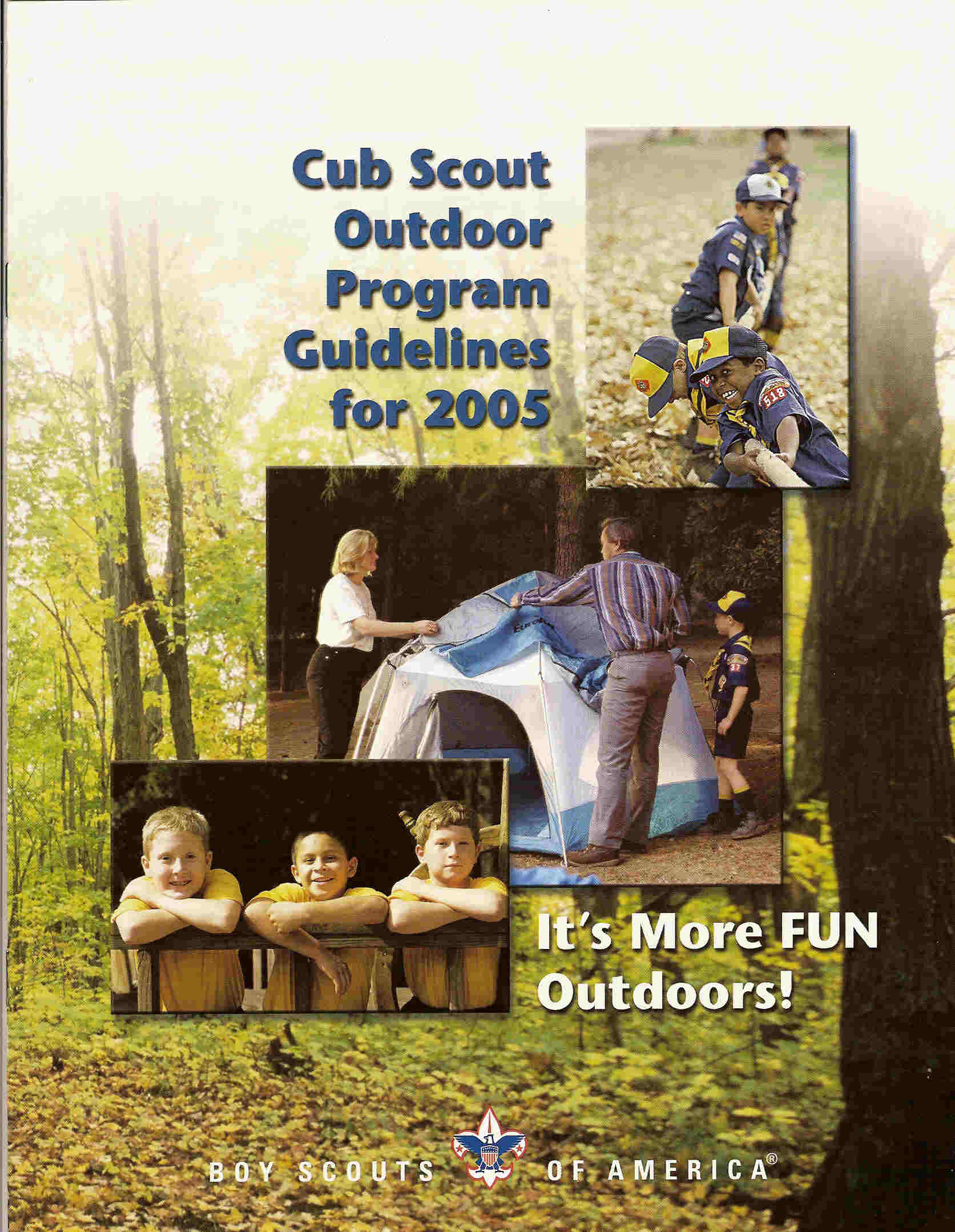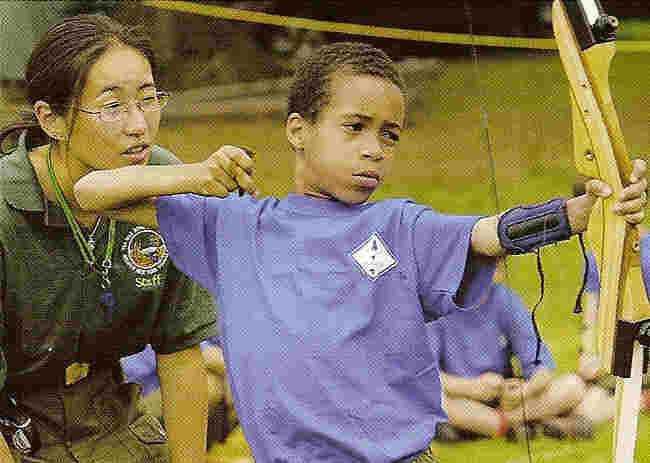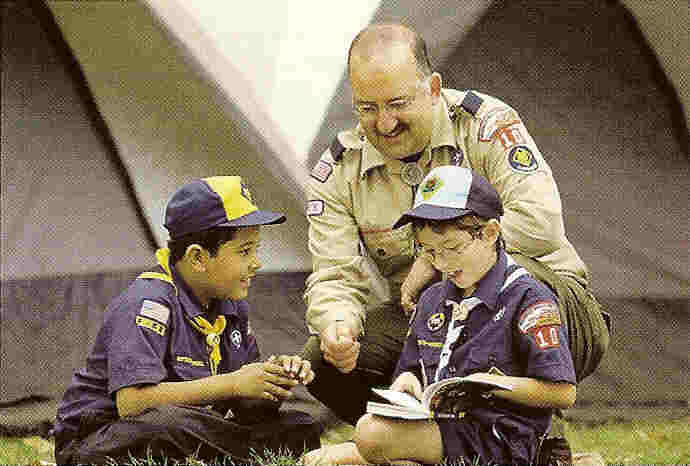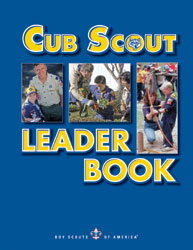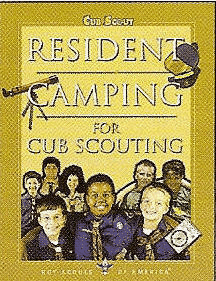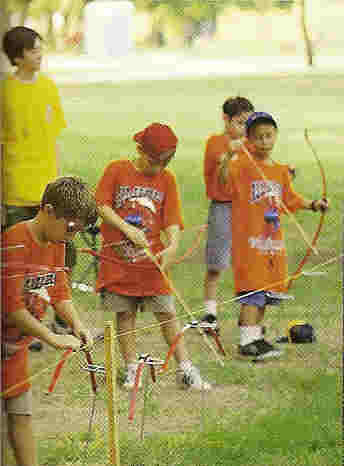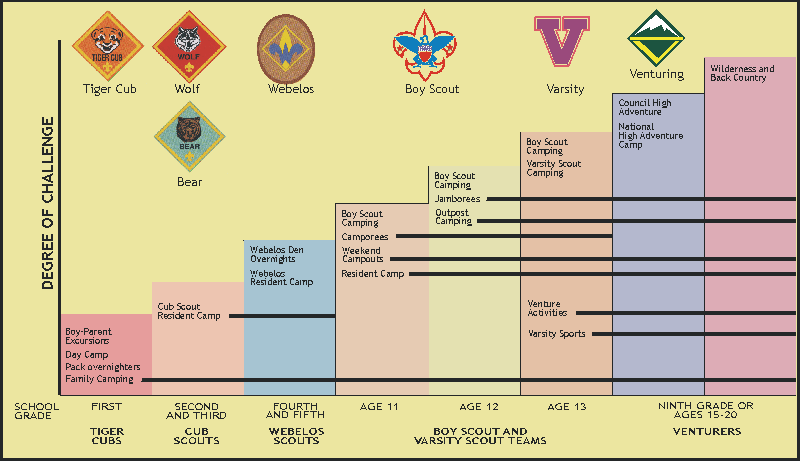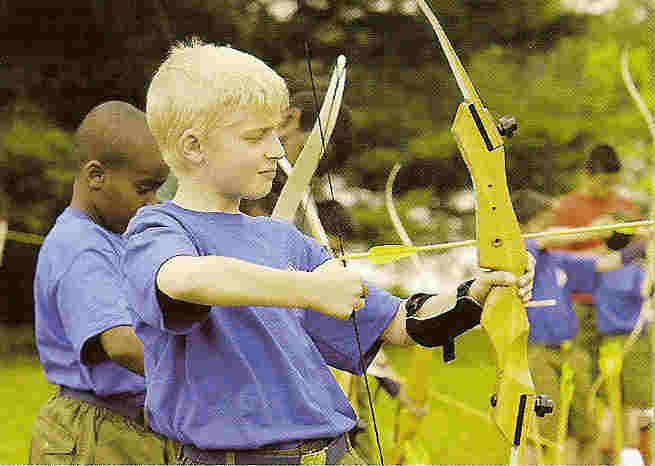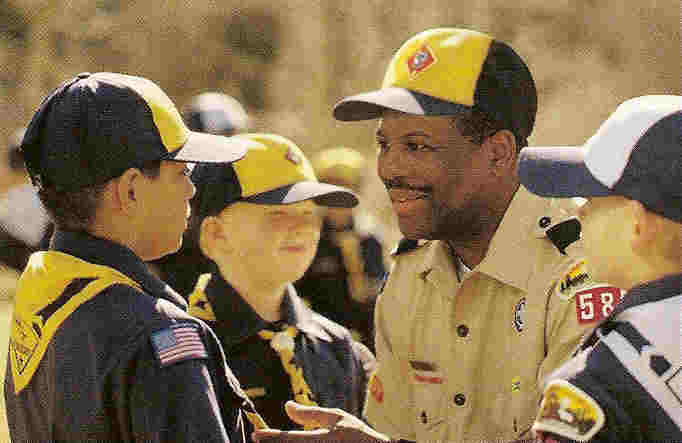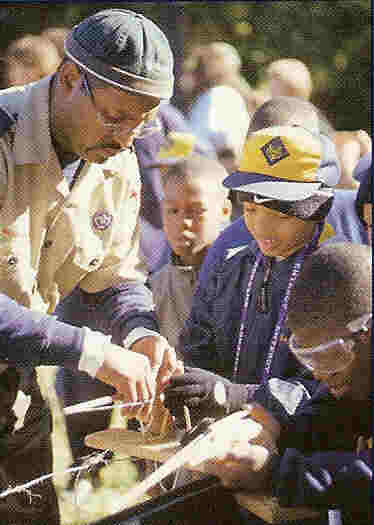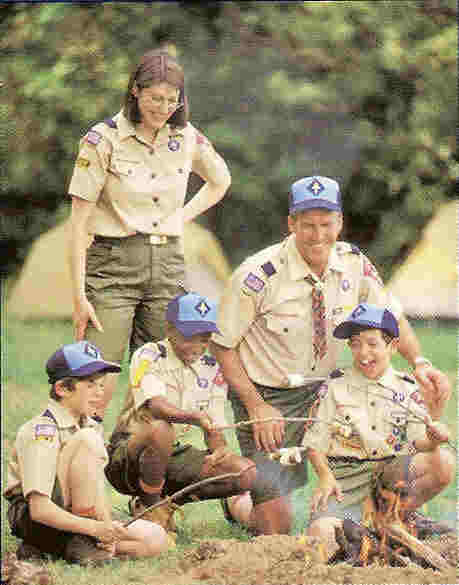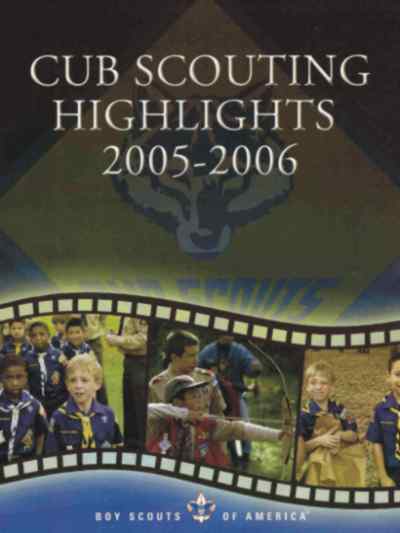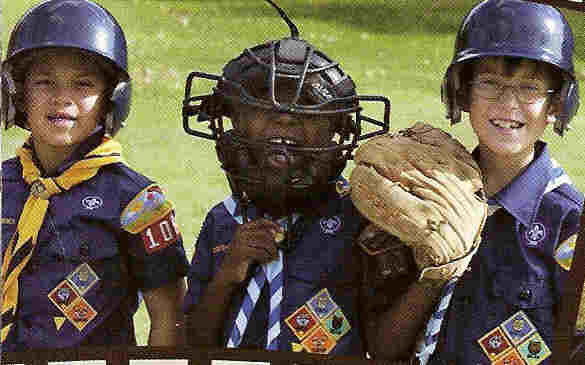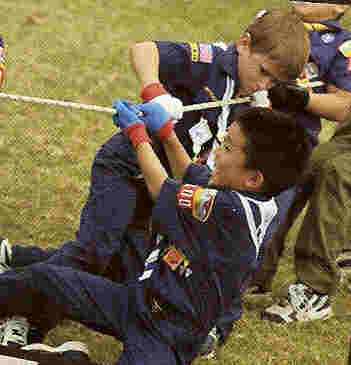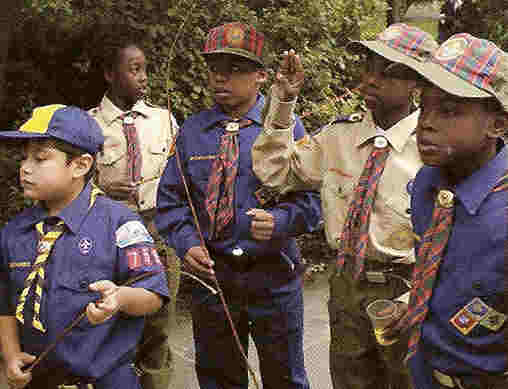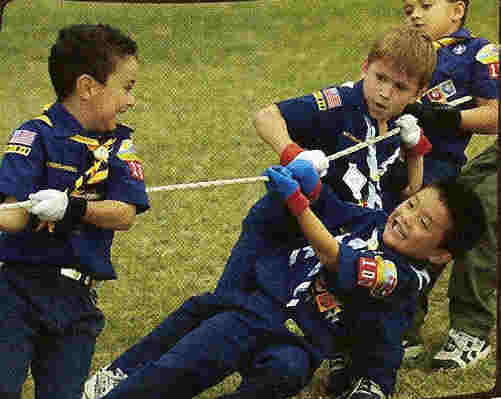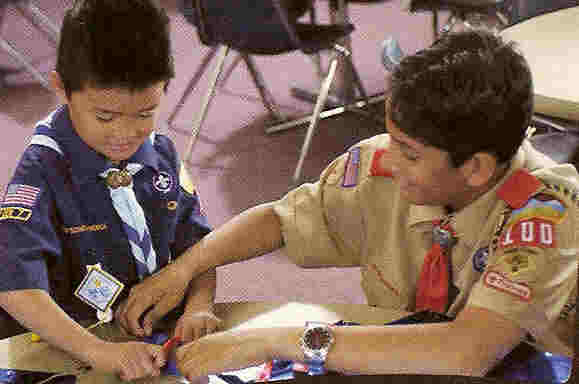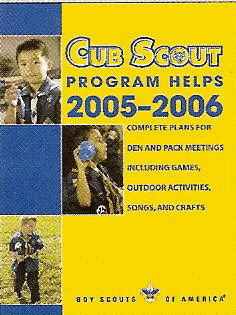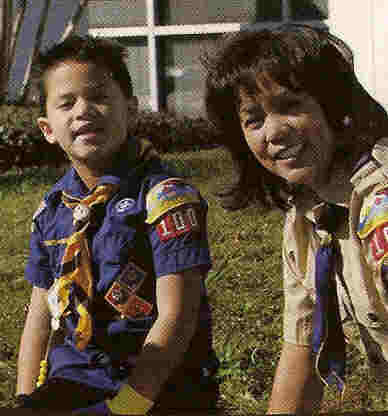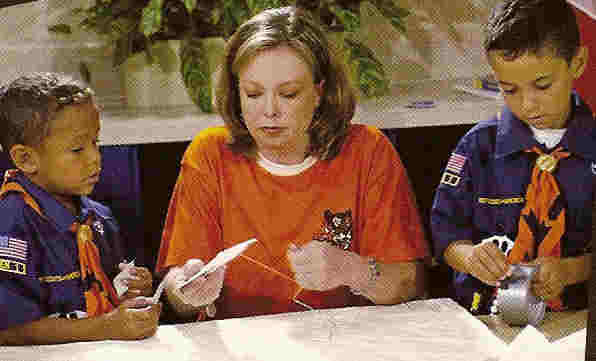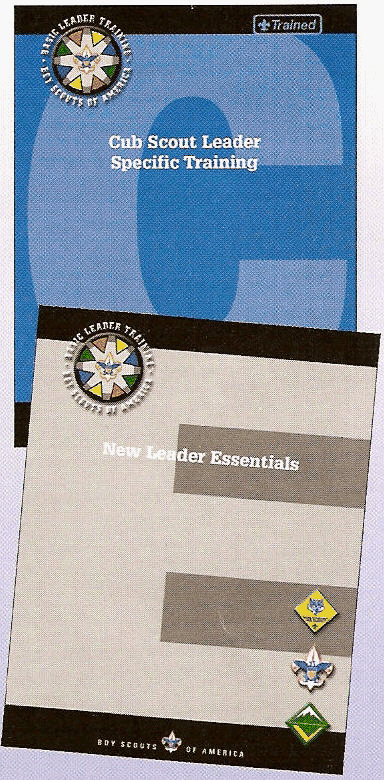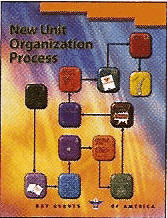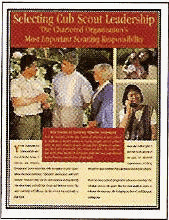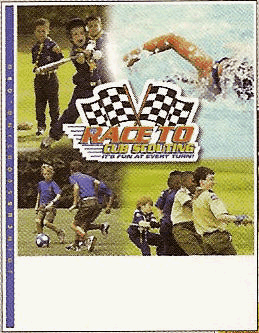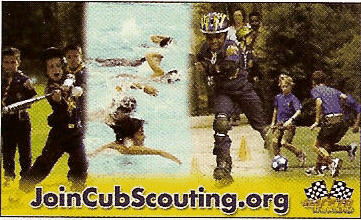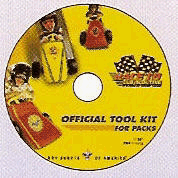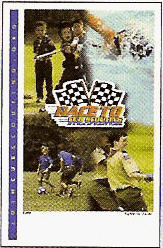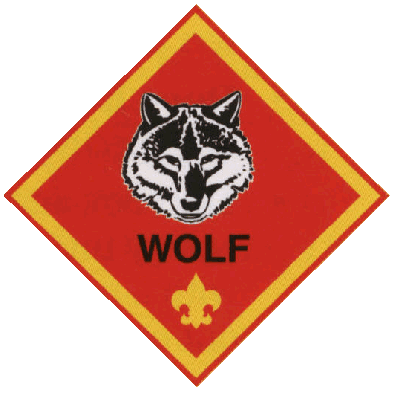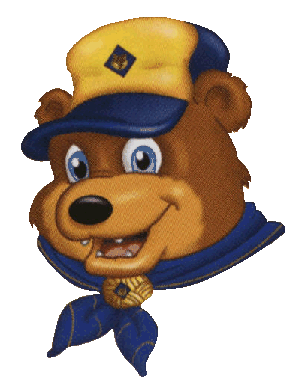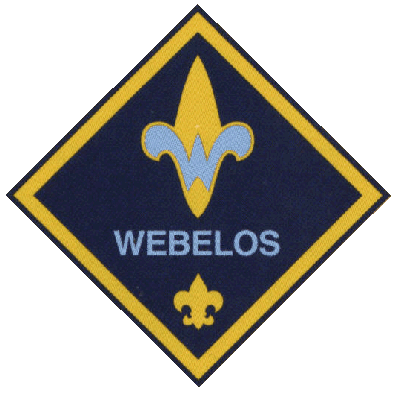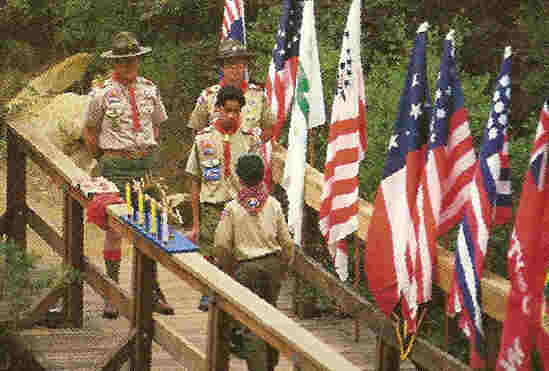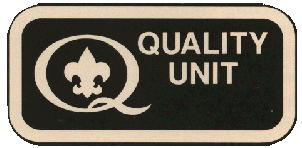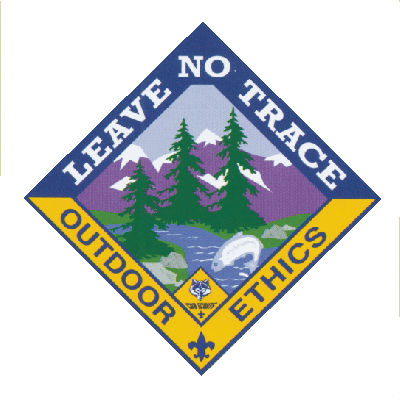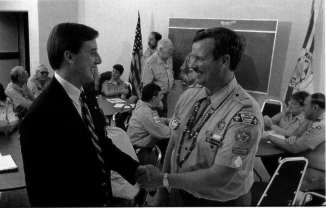Council-Organized Family Camps
Council-organized family camps
are overnight camping activities involving more than one pack. The local
council or district provides the elements of the outdoor experience, such
as staffing, food service, housing, and program. These overnighters often
are referred to as Parent-Pal or Adventure weekends. In most cases, the
youth member will be under the supervision of a parent or guardian. In
all cases, each youth participant is responsible to a specific adult.
Leadership of these functions
is provided through the family camp administrator, who is at least 21 years
of age and has successfully completed National Camping School training
in Resident Camp Management. It is his or her responsibility to promote,
schedule, and oversee the family camping opportunities in the council.
The family camp administrator has the responsibility to train family camp
directors, wagonmasters, and other staff who will be providing leadership
for the family camping activities.
Overnight activities Involving
more than one pack must
be approved by the local council.
Council-organized family camps should be conducted in accordance with established
standards as given in National Standards for Council-Organized Family Camps,
No. 13-408. |
Pack Overnighters
Pack overnighters are pack-organized
overnight camping activities involving more than one family from a single
pack, focused on age-appropriate Cub Scout activities and conducted at
council-approved locations (use Pack Overnighter Site Approval Form, No.
13-508). If nonmembers (siblings) participate, the program must be structured
to accommodate them. BSA health and safety and Youth Protection guidelines
apply. In most cases, each youth member will be under the supervision of
a parent or guardian. In all cases, each youth participant is responsible
to a specific adult.
Adults giving leadership to a
pack ovemighter must complete Basic AduitLeader Outdoor Orientation (BALOO),
No. 34162, and be present on campouts. BALOO trains participants to properly
understand the importance of program intent, Youth Protection guidelines,
health and safety, site selection, age-appropriate activities, and sufficient
adult participation. Permits for campouts shall be issued locally. Packs
use the Local Tour Permit Application, No. 34426.
BasicAduit Leader Outdoor Orientation
(BALOO), No.34162 |
Webelos Den Overnight Camping
Webelos den campouts serve to
move the Webelos Scout to the next level of the BSA’s ever-increasing challenge
in the outdoors. The boy and his parent will be introduced to the basics
of Boy Scout camping. A trained Webelos den leader who has completed position-specific
training and
Webelos leader outdoor ~atn1ng
should conduct these events.
Webelos dens are encouraged to
participate in joint den-troop campouts, particularly in the fifth-grade
year. These campouts are to be conducted with an individual troop for the
purpose of strengthening ties between the pack and the troop. BSA health
and safety and Youth Protection guidelines apply.
Webelos dens are encouraged to
visit Boy Scout camporees and Klondike derbies. The purpose of these visits
should be for the boys to look ahead with anticipation to their future
as Boy Scouts and observe troops they might join. Webelos Scouts should
not compete or participate in activities designed for Boy Scouts. Webelos
Scouts should not spend the night at the event if the program is Boy Scout—based.
To provide leadership for this
event,
Webelos leaders should complete
the
course, Outdoor Leader Skills
for Webelos Leaders, No. 13-
33640, due out in early 2005.
Cub Scout Leader Book, No. 33221
Webelos Leader Guide, No. 33853
Webelos—Ree
It’s coming in early 2005! The
Webelos-Ree is a district or council overnight camping experience for local
Webelos dens to participate with den leadership present. The local council
or district sponsors the event and provides the program and leadership.The
location is approved by an appropriate committee determined by the council.
The local council sets the ratio of Webelos Scouts to adults for the event.
In most cases, each boy will be accompanied by a parent or guardian. In
all cases, a responsible adult will be designated for each youth participant.
BSA Youth Protection standards will apply regarding sleeping and bathroom
arrangements.
This camporee-style event is intended
for Webelos Scouts, with events and activities planned for their ability
level. Boy Scouts should participate only in leadership and support capacity.
Key staff members should be trained in Outdoor Leader Skills for Webelos
Leaders, No. 13~33640, also due out in early 2005. A program guide, “Conducting
a Webelos-Ree,” will be available in 2005. |
Standards for Privacy on Trips
or Outings
To support the BSA policy of two-deep
leadership on all trips and outings, we must address the sleeping arrangements
of male and female leaders.
All leaders are expected to reflect
high moral standards established by customs, traditional values, and religious
teachings. Male and female leaders require separate sleeping facilities.
Married couples may share the same quarters if appropriate facilities are
available.
Male and female youth participants
must not share the same sleeping facility. When tents are used, no youth
will stay in the tent of an adult other than his/her parent or guardian.
When housing other than tents
is used, separate housing must be provided for male and female participants.
Adult male leaders must be responsible for the male participants, and the
same goes for female participants.
Adult leaders need to respect
the privacy of the youth members in situations where the youth are changing
clothes or taking showers, and intrude only to the extent that health
and safety require. Adults need to protect their own privacy In similar
situations.
Although it is not mandatory,
councils are strongly encouraged to have separate shower and latrine facilities
for females. In camps where separate facilities are not available, separate
shower schedules for males and females should be posted. Use the buddy
system for latrine use by having one person wait outside the entrance,
or use Occupied or Unoccupied signs on door latches.
Guide to Safe Scouting, No. 34416
National Summertime
Pack Award
The purpose of the National Summertime
Pack Award is to encourage packs to provide a year-round program by continuing
to meet during the periods when school is out of session for several weeks
or months. If a pack is in a “year-round school” (or part
of a home-school association)
that has several three- or fourweek breaks at various times during the
year, the award can be earned during those breaks.
The award consists of an individual
pin for youth uniform wear, an individual certificate, and a unit banner.
The pin is worn on the right pocket flap of the uniform shirt. |
Cub Scout Trips and Excursions
Trips or excursions by Cub Scout
packs under chartered organization leadership are a recognized part of
the Cub Scout program. Trips should be conducted in accordance with established
procedures. Permits for such tours shall be issued locally or nationally,
depending on the distance traveled.
The National Council has established
the following guidelines:
• Trips normally will be one—day
excursions.
• Overnight stays are permitted
but they are not encouraged.
• When overnight stays are necessary,
participants will stay in private homes, motels, or hotels.
• Lock-ins or overnight progranmring
at local museums or other appropriate locations may be approved by the
local council.
• Den leaders, pack leaders, and
parents are expected to accompany the boys on approved trips.
• Tiger Cubs are limited to boy—adult
partner excursions, day camps, pack overnighters, and council-approved
family camping.
Cub Scout World Conservation Award
Cub Scouts and Webelos Scouts
who have participated in either a den or a pack conservation project and
have completed certain requirements can earn the World Conservation Award.
Each age group has specific
requirements. Wolf Cub Scouts
complete Wolf Achievement 7 and two electives and take part in a den or
pack conservation project. Bear Cub Scouts complete Bear Achievement 5
and all projects in two electives, and take part in a den or pack conservation
project. Webelos Scouts earn three activity badges in addition to taking
part in a den or pack conservation project. Tiger Cubs do not earn the
World Conservation Award.
The award is worn as a temporary
patch, centered on the right pocket of the uniform shirt.
Cub ScoutLeader Book, No. 33221
Cub Scout
Shooting Sports
Shooting sports provide fun and
adventure for boys. Archery and BB gun shooting teach skills, discipline,
self-reliance, sportsmanship, and conservation, all of which are elements
of good character valued by Scouters.
Archery and BB gun shootng are
restricted to day camps, Cub Scout/Webelos Scout resident camps, council-managed
family camping programs, or council activities where there are properly
trained supervisors and all standards for BSA shooting sports are enforced.
Archery and BB gun shooting are not to be done at the pack level.
Archery and BB gun shooting belt
ioops and pins may be earned only at the camps and activities listed above.
These programs are designed to emphasize safety and marksmanship development
under the direction of trained range officers using nationally approved
instructional methods.
Shooting Sports for Cub Scouting,
No. 13-550 |
Highlights of Cub Scout Aquatics
Swimming
Before a BSA group may engage in
swimming activities of any kind, a minimum of one adult leader must complete
Safe Swim Defense training, have a commitment card (No, 34243) with them,
and agree to use the eight defenses in this plan. The Safe Swim Defense
plan applies to swimming at a beach, private or public pooi, wilderness
pond, stream, lake, or anywhere Scouts swim.
The following information is specific
to Cub Scout swimming activities:
• If the swimming activity is in
a public facility where others are using the pool at the same time, and
the pool operator provides guard personnel, there may be no need for additional
designation of Scout lifeguards and lookout.
• The buddy system is critically
important, however, even in a public pool. Remember, even in a crowd, you
are alone without protection if no one is attentive to your circumstances.
• The rule that people swim only
in water suited to their ability and with others of similar ability applies
in a pool environment. Most public pools divide shallow and deep water,
and this may be sufficient for defining appropriate swimming areas.
• Aquatics activities for dens
often are held In backyards with swimming poois. Safe Swim Defense guidelines
must apply. A certified lifeguard, though highly recommended, is not required.
A qualified supervisor must be present. It is critical that the swimming
activity be supervised by a conscientious adult who knowingly accepts the
responsibility for the youth members involved in the activity.
Boating
Before a BSA group may engage
in an excursion, expedition, or trip on the water (by canoe, raft, sailboat,
motorboat, rowboat, tube, or other craft), adult leaders for such activity
must complete Safety Afloat training, have a commitment card (No. 34242A)
with them, and be dedicated to full compliance with all nine points of
Safety Afloat.
The following information is specific
to Cub Scout boating activities:
• Supervision—the ratio of adult
supervisors to participants is one to five.
• Skill Proflciency—Canoeing,
rowboating, and rafting for Cub Scouts (including Webelos Scouts) is limited
to council/district events on flat-water ponds or controlled lake areas
free of powerboats and sailboats. Prior to recreational canoeing, Cub Scouts
are to be instructed in basic handling skills and practices.
• Planning—Canoeing, rowboating,
and rafting do not include “trips” or “expeditions” and are not to be conducted
on running water (i.e., rivers or streams); therefore, some procedures
are inapplicable. Suitable weather requires clear skies, no appreciable
wind, and warm air and water
• PFDs—All persons engaged in
activity on the open water must wear properly fitted U.S. Coast Guard—approved
personal flotation devices (PFD5).
• Scuba—Youth members in Cub Scouting
are not authorized to use scuba in any activity. |
Cub Scout Outdoor Activity
Award
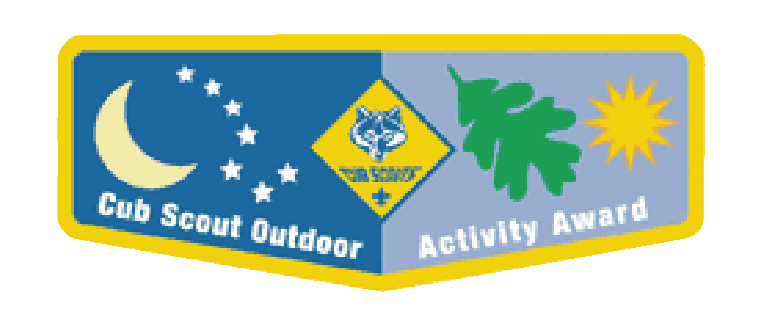 Tiger Cubs, Wolf and Bear Cub Scouts,
and Webelos Scouts have the opportunity to earn the Cub Scout
Tiger Cubs, Wolf and Bear Cub Scouts,
and Webelos Scouts have the opportunity to earn the Cub Scout
Outdoor Activity Award. Boys may
earn the award in each of the program ears as long as the requirements
are completed each year.
The first time the award is earned,
the boy will receive the pocket flap award, which is to be worn on the
right pocket flap of the uniform shirt. Each successive time the award
is earned, a wolf track pin may be added to the flap. Leaders should encourage
boys to build on skills and experiences from previous years when working
on the award for a successive year. |
Requirements
All Ranks
Attend Cub Scout day camp or Cub
Scout/Webelos Scout resident camp.
Rank-Specific
Tiger Cubs. Complete one requirement
in Achievement 5, “Let’s Go Outdoors” (Tiger Cab Handbook) and complete
three of the outdoor activities.
Wolf Cub Scouts. Assemble the
“Six Essentials for Going Outdoors” (Wolf Handbook, Elective 23b) and discuss
their purpose, and complete four of the outdoor activities.
Bear Cub Scouts. Earn the Cub
Scout Leave No Trace Award (Bear Handbook, Elective 25h) and compete five
of the outdoor activities.
Webelos Scouts. Earn the Outdoorsman
Activity Badge (Webelos Handbook); and complete six of the outdoor activities.
CubScout Outdoor Activity Award, No. 13-228 |


 Back to Roundtable
Back to Roundtable
